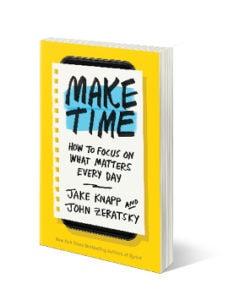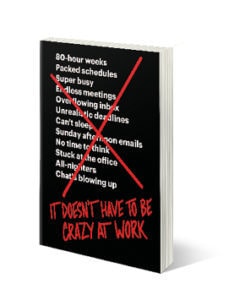A lot of people are good at what they do. Some are even elite. A
select few are completely unstoppable.
Those who are unstoppable are in their own world. They don’t compete with anyone but themselves. You never know what they will do—only that you will be forced to respond. Even though they don’t compete with you, they make you compete with them.
Are you unstoppable? By the end of this blog you will be.
Let’s get started:
1. Don’t think—know and act.
“Don’t think. You already know what you have to do, and you know how to do it. What’s stopping you?” — Tim Grover, author of
Relentless: From Good to Great to UnstoppableRather than analyzing and thinking, act. Attuned to your senses, and with complete trust in yourself, do what you instinctively
feel you should. As Oprah has said, “Every right decision I have ever made has come from my gut. Every wrong decision I’ve made was the result of me not listening to the greater voice of myself.”
The moment you start thinking, you’ve already lost. Thinking swiftly pulls you out of the zone.
2. Always be prepared so you have the freedom to act on instinct.
“Just as the yin-yang symbol possesses a kernel of light in the dark, and of dark in the light, creative leaps are grounded in a technical foundation.” — Josh Waitzkin, author of
The Art of Learning: An Inner Journey to Optimal PerformanceBecome a master of your craft. While everyone else is relaxing, you’re practicing and perfecting. Learn the left-brained rules in and out so your right brain can have limitless freedom to break the rules and
create.With enhanced consciousness, time will slow down for you. You’ll see things in several more frames than others. While they’re trying to react to the situation, you’ll be able to manipulate and tweak the situation to your liking.
3. Don’t be motivated by money or anything external.
Having nice things is, well, nice. But for you, it’s never been about the money, prestige or anything else outside of you. Take these things away and nothing changes for you. You’re still going to be pushing your personal limits and giving it your all. Give these things to you and they won’t destroy you like they do most people.
4. Never be satisfied.
“The drive to close the gap between near-perfect and perfect is the difference between great and unstoppable.” — Tim Grover
Even after you
achieve a goal, you’re not content. For you, it’s not even about the goal. It’s about the climb to see how far you can push yourself.
Does this make you ungrateful? Absolutely not. You’re entirely humbled and grateful for everything in your life. Which is why you will never get complacent or lazy.
5. Always be in control.
Unlike most people, who are dependent on substances or other external factors, you are in control of what you put in your body, how you spend your time and how long you stay in the zone.
Act based on instinct, not impulse. Just because you
could doesn’t mean you
do. And when you do, it’s because you want to, not because you have to.
6. Be true to yourself.
Although
70 percent of US employees hate their jobs and only
one in three Americans report being happy, relentless and unstoppable people purge everything from their life they hate.
Have the self-respect and confidence to live life on your terms. When something isn’t right in your life, change it. Immediately.
7. Never let off the pressure.
“Pressure can bust pipes, but it also can make diamonds.” — Tim Grover
Most people can handle pressure in small doses. But when left to their own devices, they let off the pressure and relax.
Not you. You never take the pressure off yourself. Instead, you continuously turn-up the pressure. It’s what keeps you alert and active.
8. Don’t be afraid of the consequences of failure.
Most people stay close to the ground, where it’s safe. If they fall, it won’t hurt that bad. But when you choose to fly high, the fall may kill you. And you’re OK with that. To you, there is no ceiling and there is no floor. It’s all in your head. If something goes wrong—if you “fail”—you adjust and keep going.
9. Don’t compete with others. Make them compete with you.
Most people are competing with
other people. They continuously check-in to see what others in their space (their “competition”) are doing. As a result, they mimic and copy what’s “working.”
Conversely, you’ve left all competition behind. Competing with others makes absolutely zero sense to you. It pulls you from your authentic zone. So you zone out all the external noise and instead zone in to your internal pressure to produce.
10. Never stop learning.
Ordinary people seek entertainment. Extraordinary people seek education and learning. When you want to become the best at what you do, you
never stop learning. You never stop improving and honing your skills and knowledge.
Your unparalleled preparation is what gives you power. No one else is willing to pay the price you’ve paid.
11. Success isn’t enough—it only increases the pressure.
For most people, becoming “successful” is enough. However, when you’re relentless
, success only increases the pressure to do more. Immediately following the achievement of a goal, you’re focused on your next challenge.
12. Don’t get crushed by success.
“Success can become a catalyst for failure.” — Greg McKeown, author of
Essentialism: The Disciplined Pursuit of LessMost people can’t handle success, authority or privilege. It destroys them. It makes them lazy. When they get what they want, they stop doing the very things that got them there. The external noise becomes too intense.
But for you, no external noise can push harder than your own internal pressure. It’s not about
this achievement, but the one after, and the one after that. There is no destination. Only when you’re finished.
13. Completely own it when you screw up.
“Implementing extreme ownership requires checking your ego and operating with a high degree of humility. Admitting mistakes, taking ownership and developing a plan to overcome challenges are integral to any successful team.”―Jocko Willink, author of
Extreme Ownership: How U.S. Navy SEALs Lead and WinNo blame. No deception or illusion. Just the cold hard truth. When you mess up, you own it. And as the leader, you own it when your team fails. Only with extreme ownership can you have complete freedom and control.
14. Let your work speak for itself.
“Well done, is well said.” — Anthony Liccione, poet and author
Cal Newport’s recent book,
Deep Work, distinguishes “deep work” from “shallow work.” Here’s the difference:
Deep work is:
- Rare
- High value
- And non-replicable (i.e., not easy to copy/outsource)
Shallow work is:
- Common
- Low value
- Replicable (i.e., anyone can do it)
Talking is shallow. Anyone can do it. It’s easily replicated. It’s low value. Conversely, deep work is rare. It’s done by people who are focused and working while everyone else is talking. Deep work is so good it can’t be ignored. It doesn’t need words. It speaks for itself.
“Mental resilience is arguably the most critical trait of a world-class performer, and it should be nurtured continuously. Left to my own devices, I am always looking for ways to become more and more psychologically impregnable. When uncomfortable, my instinct is not to avoid the discomfort but to become at peace with it. My instinct is always to seek out challenges as opposed to avoiding them.” — Josh Waitzkin
The better you can be under pressure, the further you’ll go than anyone else. Because they’ll crumble under pressure.
The best training you will ever do is mental training. Wherever your mind goes, your body follows. Wherever your thoughts go, your life follows.
16. Confidence is your greatest asset.
You’ve heard it before: Running a marathon is far more mental than physical. A person’s ability to run a marathon—or do anything hard—is more a reflection of their
level of confidence than their actual ability.
Your confidence determines:
- The size of challenges/goals you undertake
- How likely you will achieve those goals
- How well you bounce back from failures
If you’re not confident, you will never put yourself out there in the first place. When you’re confident, you don’t care how many times you fail, you’re going to succeed. And it doesn’t matter how stacked the odds seem against you.
17. Surround yourself with people who remind you of the future, not the past.
When you surround yourself with people who remind you of your past, you’ll have a hard time progressing. This is why we get stuck in certain roles, which we can’t break free from (e.g., the fat kid or shy guy).
Surrounding yourself with people who you want to be like allows you a fresh slate. You’re no longer defined by your past, only the future you are creating.
18. Let things go, but never forget.
Being unstoppable requires carrying no unnecessary mental or emotional baggage. Consequently, you’ll need to immediately and completely forgive anyone who has wronged you. However, forgiveness doesn’t mean you forget. And it doesn’t mean you have to do further business with those who have wronged you.
19. Have clear goals.
“While a fixation on results is certainly unhealthy, short-term goals can be useful developmental tools if they are balanced within a nurturing long-term philosophy.” — Josh Waitzkin
According to loads of psychology research, the most motivating goals are clearly defined and time-bound.
Your goals can either be focused on your behaviors (e.g., I’m going to write 500 words per day) or on the outcomes you’re seeking (e.g., I’m going to get published on
The New York Times by June 1, 2016
).For most people, behaviorally-focused goals are the better and more motivating option. But when you crave the results so much that the work is irrelevant, your aim should be directed straight at the outcomes you want. However, results-focused goals are better when short-term and grounded in your long-term vision and philosophy. When your
why is strong enough, the
how will take care of itself.
20. Respond immediately, rather than analyzing or stalling.
“He who hesitates is lost.” — Cato
Anticipation of an event is always more extreme than the event itself—both for
positive and
negative events.
Just do it. Train yourself to respond immediately when you feel you should do something. Stop questioning yourself. Don’t analyze it. Don’t question if it came from God or from yourself. Just act.
You’ll figure out what to do
after you’ve taken action. Until you take action, it will all be hypothetical. But once you act, it becomes practical.
21. Choose simplicity over complication.
“If you can’t explain it simply, you don’t understand it well enough.” — Albert Einstein
It’s easy to be complicated. Most of the research and jargon in academia and business is over-complicated.
Cutting to the core and hitting the truth is hard, because it’s simple. As Leonardo da Vinci has said,
“Simplicity is the ultimate sophistication.”Very few people will give you the truth. When you ask them a question, it gets mighty complicated. “There are so many variables” or “It depends” they say.
T. S. Eliot said it best,
“Where is the wisdom we have lost in knowledge? Where is the knowledge we have lost in information?”Wisdom is timeless and simple. Learn wisdom and choose it.
22. Never be jealous or envious of someone else’s accomplishments.
Being unstoppable means you genuinely want what’s best for everyone—even those you would consider your competitors. Jealousy and envy are the ego—which operates out of fear.
The reason you are happy for other people’s success is because their success has nothing to do with you.
You are in control of you. And you are different from every other person. There is no one who can do exactly what you can do. You have your own superpower with your own unique ability to contribute. And that’s what you’re going to do.
23. Take the shot every time.
“If I fail more than you, I win.” —Seth Godin, author and marketer
You miss every shot you don’t take. And most people don’t want to take the shot. Fear of failure paralyzes them.
The only way you can become unstoppable is if you stop thinking about it. Just take the shot. Don’t do it only when it’s convenient or when you feel ready. Just go and make whatever adjustments you need after the fact.
24. Don’t get caught up in the results of your success. Always remain focused on what got you those results: the work.
When you start doing noteworthy stuff, there are benefits that can become distractions. It can get easy to “ride the wave” of your previous work. Keep practicing. Perfect your craft. Never forget what got you here.
25. Think and act 10X.
“When 10X is your measuring stick, you immediately see how you can bypass what everyone else is doing.” —Dan Sullivan, founder of
Strategic CoachMost people—even those you deem to be “world class”—are not operating at 10X. In truth, you could surpass
anyone if you radically stretch your thinking and belief system.
Going 10X changes everything. As Dan Sullivan has said, “10X thinking automatically takes you ‘outside the box’ of your present obstacles and limitations.” It pulls you out of the problems most people are dealing with and opens you to an entirely new field of possibilities.
When you take your goal of earning $100,000 this year and change it to $1,000,000, you’re forced to operate at a different level. The logical and traditional approach doesn’t work with 10X. As Shane Snow, author of
Smartcuts: How Hackers, Innovators, and Icons Accelerate Success, has said, “10x progress is built on bravery and creativity instead. Working smarter.”
The question is: Are you willing to go
there? Not just entertain the thought for a second or two and then revert back to common thinking. No. Are you willing to sit with 10X thinking? Are you willing to question your own thought processes and open yourself to believing an entirely different set of possibilities?
Could you convince yourself to believe in your 10X potential? Are you willing to undertake goals that seems lunacy, to you and everyone else? Are you willing to take the mental leap, trusting “the universe will conspire to make it happen”?
26. Set goals that far exceed your current capabilities.
“You need to aim beyond what you are capable of. You need to develop a complete disregard for where your abilities end. If you think you’re unable to work for the best company in its sphere, make that your aim. If you think you’re unable to be on the cover of TIME
magazine, make it your business to be there. Make your vision of where you want to be a reality. Nothing is impossible.” — Paul Arden, author of
It’s Not How Good You Are, It’s How Good You Want to BeIf your goals are logical, they won’t force you to create luck. Being unstoppable means your goals challenge you to be someone more than you currently are. As Jim Rohn has said, “Don’t wish it was easier, wish you were better.”
27. Make time for recovery and rejuvenation.
“Wherever you are, make sure you’re there.” — Dan Sullivan
When you focus on results, rather than being busy, you’re 100 percent
on when you’re working and 100 percent
off when you’re not. This not only allows you to be present in the moment, but it allows you the needed time to rest and recover.
Your ability to work at a high level is like fitness. If you never
take a break between sets, you won’t be able to build strength, stamina and endurance. However, not all “rest” produces recovery. Certain things are more soothing than others.
Recovering from my work generally consists of writing in my journal, listening to music, spending time with my wife and kids, preparing and eating delicious food, or serving other people. These things rejuvenate me. They make my work possible, but also meaningful.
28. Start before you’re ready.
“The best time to plant a tree was 20 years ago. The second best time is now.” — Chinese Proverb
Most people wait. They believe they can start after they have enough time, money, connections and credentials. They wait until they feel “secure.” Not people who are unstoppable.
Unstoppable people started last year. They started five years ago before they even knew what they were doing. They started before they had any money. They started before they had all the answers. They started when no one else believed in them. The only permission they needed was the voice inside them prompting them to move forward. And they moved.
29. If you need permission, you probably shouldn’t do it.
A mentor of mine is a highly successful real estate investor. Throughout his career, he’s had hundreds of people ask him if they should “go into real-estate.”
He tells every one of them the same thing: that they shouldn’t do it. In fact, he actually tries talking most of them
out of it. And in most cases he succeeds.
Why would he do that? “Those who are going to succeed will do so regardless of what I say,” he told me.
I know so many people who chase whatever worked for other people. They never truly decide what
they want to do, and end up jumping from one thing to the next—trying to strike quick gold. And repetitively, they stop digging just a few feet from the gold after resigning the spot is barren.
No one will ever give you permission to live your dreams.
30. Don’t make exceptions.
Zig Ziglar used to tell a story of traveling one day and not getting in bed until 4 a.m. An hour and a half later (5:30), his alarm went off. He said, “Every fiber of my being was telling me to stay in bed.” But he had made a commitment, so he got up anyway. Admittedly, he had a horrible day and wasn’t productive at all.
Yet, he says that decision changed his life. As he explains:
“Had I bowed to my human, physical, emotional and mental desire to sleep in, I would have made that exception. A week later, I might have made an exception if I only got four hours of sleep. A week later, maybe I only got seven hours of sleep. The exception so many times becomes the rule. Had I slept in, I would’ve faced that danger. Watch those exceptions!”
Hence, Zig was unstoppable.
“From this point, your strategy is to make everyone else get on your level, you’re not going down to theirs. You’re not competing with anyone else, ever again. They’re going to have to compete with you. From now on, the end result is all that matters.” — Tim Grover
When you’re unstoppable, you will make sure to get what you want. Everything you need to know is already within you. All you need to do is trust yourself and act.
Are you unstoppable?



 1. Make Time
1. Make Time 2. It Doesn’t Have to Be Crazy at Work
2. It Doesn’t Have to Be Crazy at Work 3. The Laws of Human Nature
3. The Laws of Human Nature 4. Radical Generosity
4. Radical Generosity 5. Can You Learn to Be Lucky?
5. Can You Learn to Be Lucky? 6. Thirst
6. Thirst

:max_bytes(150000):strip_icc():format(webp)/GettyImages-898430844-5a7215cf8e1b6e0037e55441.jpg)
:max_bytes(150000):strip_icc():format(webp)/182066166-56a5b71c3df78cf772898739.jpg)